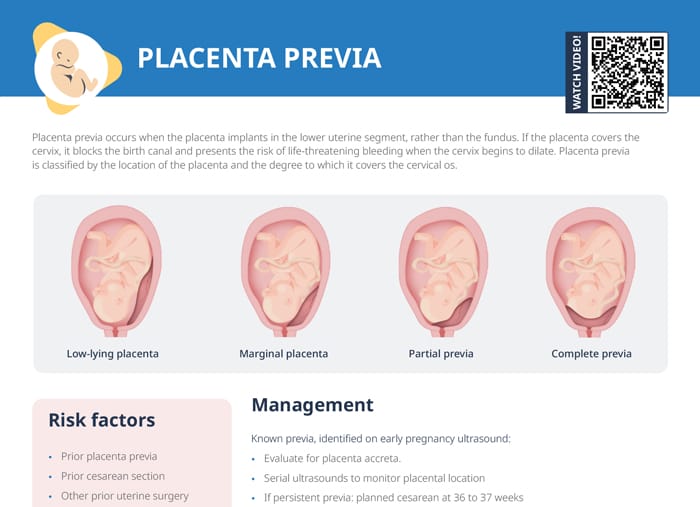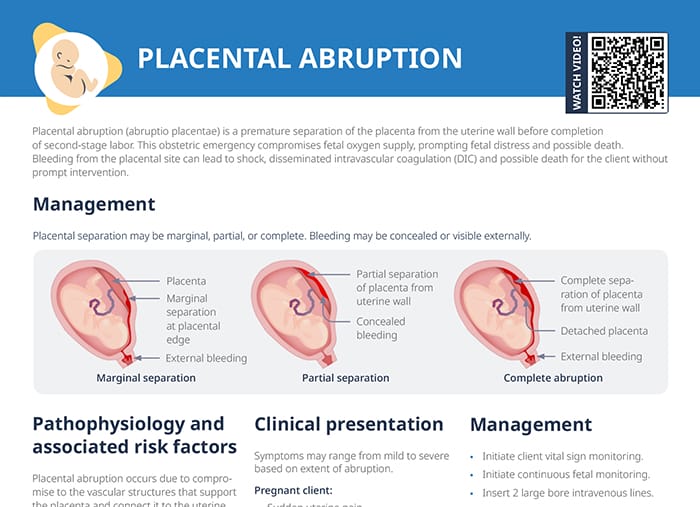What is placental abruption?
Placental abruption, also referred to as abruptio placentae, is a premature separation of the placenta from the uterine wall before completion of second-stage labor.
This obstetric emergency compromises fetal oxygen supply, prompting fetal distress and possible death. Bleeding from the placental site can lead to shock, disseminated intravascular coagulation (DIC), and possible death for the client without prompt intervention.
Related videos
Causes and risk factors for placental abruption
Placental abruption occurs due to compromise to the vascular structures that support the placenta and connect it to the uterine lining. This vascular compromise may occur due to:
- Increased pressure:
- Hypertension
- Preeclampsia
- Abnormal vasoconstriction:
- Smoking
- Cocaine use
- Over-stretching of the uterus:
- Polyhydramnios
- Multiple gestation
- Shearing force/trauma (fall, car wreck, physical abuse)
- Other risk factors include:
- Client age > 35
- History of placental abruption in prior pregnancy
Symptoms of placental abruption
Symptoms may range from mild to severe based on the extent of abruption.
The pregnant client presents with sudden uterine pain and sustained uterine contraction/rigid abdomen. Bleeding could be present or absent. If bleeding is severe, there could be vital sign alterations and clotting profile alterations (hypofibrinogenemia, coagulopathy).
In the fetus, placental abruption presents with decreased fetal movement and FHR, late decelerations, and sustained bradycardia.
Placenta previa vs placental abruption
Both of these conditions are obstetric emergencies that can be life-threatening to the pregnant client and the fetus, and both are related to the position/location of the placenta.
The key differences lie in the symptoms, causes, and interventions:
Table: Placenta previa vs placental abruption
| Placenta previa | Placental abruption | |
| Definition + causes | Placenta located low, covering cervical os | Placenta detaching from uterine wall before delivery |
| Presentation | Painless bleeding in 3rd trimester | Painful bleeding and contractions |
| Management | Pelvic rest and potentially cesarean delivery | Hospitalization; can require immediate delivery |
Evaluation and nursing diagnosis for placental abruption
Evaluation for placental abruption
- Ultrasound is used to identify the placental location to rule out previa; however, ultrasound has a low sensitivity for identifying acute abruption.
- Labs: CBC, clotting studies (fibrinogen and PT/aPTT), type/screen, Kleihauer–Betke
- Assess fetal wellbeing. Score of 6 or below indicates fetal compromise.
Placental abruption nursing diagnosis
Potential important nursing diagnoses related to placental abruption include:
- Risk for fetal injury due to the potential compromise in fetal oxygenation
- Risk for maternal injury due to the possibility of significant hemorrhage
- Acute pain related to uterine cramping
- Deficient fluid volume related to hemorrhage
- Anxiety due to the unpredictability and potential severity of the condition
Nursing interventions for placental abruption
The main nursing tasks when caring for a client with placental abruptions include:
- Close monitoring of vital signs or parent and fetus (FHR)
- Being prepared for rapid intervention in the case of hemorrhage (monitoring for signs of shock, bed rest, having transfusions ready)
- Preparing for the delivery/being prepared for emergency delivery
- Pain and fluid management (establishing IV access)
- Emotional support and education in the very stressful and frightening situation, including discussion of potential outcomes
- Continued monitoring postpartum

